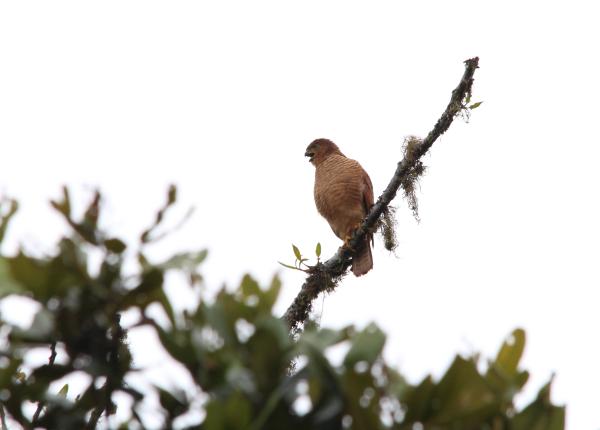Did You Know?
- The Tiny Hawk eats birds as small as hummingbirds
- It is one of the smallest raptors in the world
- Like with many raptor species, the female Tiny Hawk is larger than the male, sometimes as much as 60% bigger.
How The Peregrine Fund is Helping
The Peregrine Fund does not work directly with the Tiny Hawk, but our efforts in scientific research, habitat conservation, education, and community development help conserve raptors around the world. We also supply literature to researchers from our avian research library, which helps scientists around the world gather and share important information on raptor conservation.
Where They Live
Tiny hawks are found throughout much of the Neotropics ranging from Central to South America. They can be found in a number of different countries including Costa Rica, Panama, Nicaragua, Ecuador, Bolivia, Argentina, Paraguay and southern Brazil.
This lovely little hawk is spends most of its time in humid lowland forests, but can also be seen in foothills from sea level to about 1800 meters (5900 ft). It can be see perched in the canopy and subcanopy, along forest edges, and clearings. It also might spend some time sunning itself while perched on an exposed branch.
What They Do
As you may have guessed by its name, the Tiny Hawk is just that – a very tiny hawk! In fact, it is one of the smallest accipiters in the world. Similar to the Ridgway's Hawk, the adult males and females exhibit slightly different coloration patterns.
The adult male is covered with dark, ashy gray feathers above. Its head is lighter gray and topped with a black crown. It has a white throat and its breast and underparts are white covered with thin gray bands. The adult female, on the other hand, is a bit browner overall, than the male, and her underparts are buffier with browner barring. Adults have red eyes.
Interestingly enough, the juvenile birds have two different color morphs: brown and rufous. Brown morph juveniles are dark brown above, with thin bars of black of cinnamon. Rufous morph individuals are more chestnut in color, with rufous barring on the underparts. Immatures have yellowish eyes.
Unlike most accipiters, such as the Sharp-shinned Hawk, the Tiny Hawk has a relatively short tail. Its long toes and feet make it especially well-adapted for catching avian prey.
The Tiny Hawk is considered a sedentary species and is not known to soar very often.
Why They Need Our Help
The Tiny Hawk is listed at Least Concern by the IUCN. This means that scientists aren't immediately worried about the survival of this species. However, research shows that its population is on the decline. Climate change, loss of forest habitat, and a decline in prey availability can all have a detrimental affect on this species in the long run.
What They Eat
The Tiny Hawk is primarily a bird hunter. It preys on small passerines and has also been documented feeding on larger birds such as the Golden-green Woodpecker, as well as insects and even small rodents. However, it is believed to have a particular taste for hummingbirds. which it captures by waiting in ambush by a hummingbird's territorial perch, or by flying rapidly between several perches frequented by hummingbirds. This species also sometimes flits from perch to perch in dense vegetation, apparently hunting for small birds which it attacks in mixed flocks.
Nests, Eggs, and Young
Very little is known about the breeding biology of the Tiny Hawk. In Brazil, a nest that contained three eggs was found, however the researchers didn’t describe the nest in any more detail. Today, we know Tiny Hawks build stick nests which they may sometimes place in the canopy of tall trees. In Venezuela, a researcher observed a pair nesting in an old Black-collared Hawk nest.
During breedings season, females lay one to three pale blue-white eggs Not much else is known about their breeding habits. How long is the incubation period? How old are the nestlings whey they fly for the first time? There are so many questions for a young biologists to answer!
The Tiny Hawk and the World Center for Birds of Prey
The World Center for Birds of Prey offers fun ways to learn about birds of prey. Interactive activities, tours, interesting videos and a children's room with activities from coloring sheets to quizzes to costumes are all available for our guests. We also have knowledgeable, on-site staff to answer any questions you may have about the Tiny Hawk or any other bird of prey.
Though we don’t have any Tiny Hawks as avian ambassadors, upon visiting the World Center for Birds of Prey, you will have the chance to meet other birds of prey including a Harris’ Hawk, an Ornate Hawk-eagle and a Harpy Eagle.
References:
BirdLife International 2016. Accipiter superciliosus . The IUCN Red List of Threatened Species 2016: e.T22695565A93516273. https://dx.doi.org/10.2305/IUCN.UK.2016-3.RLTS.T22695565A93516273.en. Downloaded on 10 March 2020.
Costa, T.V.V. and Ferreira-Vargas, C., 2011. Tiny Hawk Accipiter superciliosus attacking a Golden-green Woodpecker Piculus chrysocholors in central Amazonian Brazil. Cotinga, 33, pp.134-136.
Tiny Hawk (Accipiter superciliosus), In Neotropical Birds Online (T. S. Schulenberg, Editor). Cornell Lab of Ornithology, Ithaca, NY, USA. retrieved from Neotropical Birds
Online: https://neotropical.birds.cornell.edu/SpeciesAccount/nb/species/tinhaw1
Global Raptor Information Network. 2020. Species account: Tiny Hawk Accipiter superciliosus. Downloaded from http://www.globalraptors.org on 10 Mar. 2020









